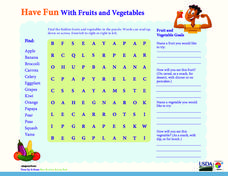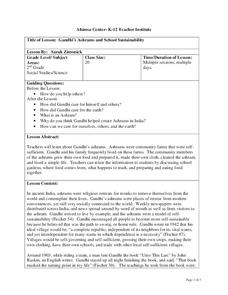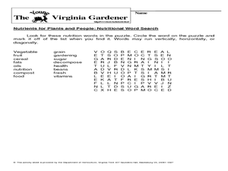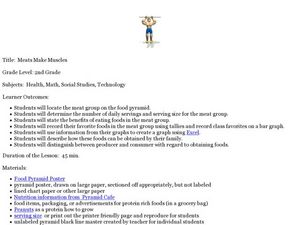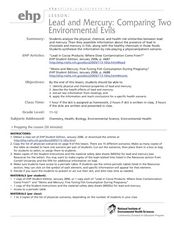Curated OER
Food Pyramid Picnic
Second graders discuss the food pyramid and appropriate choices for each food group. They plan a nutritional meal for a picnic lunch and make a class book. As a culminating event, the class plans and enjoys a picnic.
Curated OER
Get Your Calcium-Rich Foods
Sixth graders explore foods in the dairy group. In this dairy food lesson, 6th graders examine the nutritional value of dairy foods and determine the proper number of dairy servings per day. Students also evaluate numerous food labels of...
Curated OER
Food: Eating Habits
Students match pictures of people eating certain foods with the correct phrase. Student pairs interview each other in order to gather and compare information on food eating habits, and awareness of nutritional value - or lack thereof.
Curated OER
The Five Food Groups
Third graders explore the five food groups. They discuss the importance of the five food groups in their diets. Students research each of the five food groups using a WebQuest. They use the information from the WebQuest to make healthy...
Curated OER
Food For Thought
Learners examine their school population about their health and exercise patterns. They brainstorm a list of factors that influence people to eat the way they do.
Choose My Plate
MyPlate Secret Code
Can your scholars crack the code? Class members put on their detective cap to solve four sentences related to healthy eating, cooking, and the five major food groups by following a code comprised of images.
Nemours KidsHealth
School Lunch: Grades 9-12
Go! Slow! Whoa! As part of a study of the nutritional value of foods available on the school campus, groups label those that are fine anytime as "Go" foods. Those that are okay a few times a week get the "Slow" label while those...
Nemours KidsHealth
School Lunch: Grades 3-5
Two lessons encourage scholars to make smart food choices. Lesson one challenges participants to create a five-day meal plan. In lesson two, learners pack an imaginary lunch, drawing pictures on a printable lunch bag divided into food...
Choose My Plate
MyPlate Word Search
Encourage healthy eating, cooking, and goal setting with a word search that showcases a variety of fruits and vegetables, and provides a four-step plan to eat more of them.
Nemours KidsHealth
Obesity: Grades 6-8
Screen time and fast foods, sugary drinks and greasy fries have lead to one-third of tween and teens being overweight or obese. As part of the Health Problems Series scholars analyze the nutritional value of the school food services menu...
Curated OER
Gandhi's Ashrams and School Sustainability
Explore philosophy and religion by researching Gandhi. Lead your young students to investigate the life and accomplishments of Mahatma Gandhi by reading the assigned text. Your class will define sustainability and create a sustainable...
Curated OER
Full Esteem Ahead
Does having higher self esteem encourage learners to take better care of themselves? It absolutely does! Does having high self esteem mean that one likes everything about themselves? No, but that they like most things and can work to...
Nemours KidsHealth
Obesity: Grades K-2
Kids Health presents two lessons that encourage them to move their bodies and eat balanced meals. In making smart choices, learners list five exercise activities to replace screen time. Pupils discuss types of food and categorize them as...
Curated OER
Healthy Snacks
Teach little learners the difference between a healthy snack and an unhealthy one. After a class discussion about what constitutes a healthy vs. an unhealthy snack, pupils cut out pictures from magazines and sort them into categories...
Nemours KidsHealth
Media Literacy and Health: Grades 9-12
An essential skill for 21st-century learners is to know how to find reliable sources of information. Two activities help high schoolers learn how to determine the reliability of health-related news from websites, TV, magazines, or...
Curated OER
Super Size Me Video Questions
If you are planning on showing the movie Super Size Me in your health or biology class, this is a resource you will not want to overlook! Thirty-one questions keep viewers gleaning facts, and then seven more questions help them to...
FloridaHealth
The Very Hungry Caterpillar
Invite that hungry caterpillar to teach your class about nutrition! After brief instruction on fruit, the teacher reads The Very Hungry Caterpillar by Eric Carle to the class. Kids hold up the fruit images at appropriate points in the...
Howard Hughes Medical Institute
Molecular Structure of Fat
Bad fat, good fat, trans fat, food fat—are all fats created equal? Get to the bottom of the types of fat with a well-crafted presentation. The resource covers adipose tissue, lipids, trans fats, and many other substances that fall under...
Curated OER
Nutritional Word Search: Nutrients for Plants and People
Looking for something fun your young nutritionists can do when they have extra time? Although this learning exercise has little educational merit, it does serve to reiterate key nutrition terms as students search for the words in a word...
Curated OER
Meats Make Muscles
Second graders explore the meat group of the food pyramid. In this nutrition and diet lesson, 2nd graders study the benefits of eating foods in the meat group, collect data regarding their classmates' favorite foods, and create a graph...
Curated OER
Organic Mechanic Part I
On day one of the "Organic Mechanic Part I" instructional activity, learners try to remove the waxy coating of an apple and consider pesticides that may be represented by this addition to our food. On day two, they research pesticides...
Curated OER
Growing Cress: Sprouts
What does it take to grow a healthy plant? Budding horticulturists will look at each slide and consider which conditions produced the best results. Slides contain images of plants that have had too much or too little water, light, or...
Curated OER
Lead and Mercury: Comparing Two Environmental Evils
High schoolers in chemistry or health courses look at the material safety data sheet (MSDS) and periodic table of elements to gather information about mercury and lead, two toxic materials that have been found in food products. They read...
Curated OER
WHAT'S ON YOUR PLATE?
Pupils examine different food groups and identify the daily amounts of each that are necessary for healthy eating. In this food pyramid lesson students evaluate their own diets and see how they can eat more nutritiously.
Other popular searches
- Healthy Food and Teeth
- Healthy Food Pyramid
- Healthy Food Choices
- Unhealthy and Healthy Foods
- Kindergarten Healthy Foods
- Healthy Food Options
- Brainstorm Healthy Foods
- Healthy Food Craft
- Healthy Food and Drink
- Healthy Food and Snacks
- Making Healthy Food Choices
- Exercise and Healthy Foods








